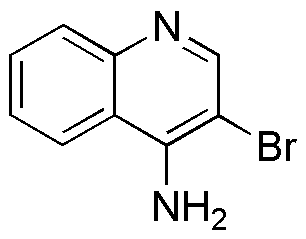3-Bromo-quinolin-4-ylamine is widely utilized in research focused on:
- Pharmaceutical Development: This compound serves as a crucial intermediate in synthesizing various pharmaceuticals, particularly those targeting cancer and infectious diseases. Its unique structure allows for modifications that enhance biological activity.
- Biological Research: Researchers use it to study enzyme inhibition and receptor interactions, providing insights into cellular processes and potential therapeutic targets.
- Material Science: It is employed in the development of novel materials, including organic semiconductors and sensors, due to its electronic properties and stability.
- Fluorescent Probes: The compound is utilized in creating fluorescent probes for imaging applications, aiding in the visualization of biological processes in live cells.
- Chemical Synthesis: As a versatile building block, it is used in the synthesis of more complex organic compounds, streamlining the process of creating new chemical entities.
General Information
Properties
Safety and Regulations
Applications
3-Bromo-quinolin-4-ylamine is widely utilized in research focused on:
- Pharmaceutical Development: This compound serves as a crucial intermediate in synthesizing various pharmaceuticals, particularly those targeting cancer and infectious diseases. Its unique structure allows for modifications that enhance biological activity.
- Biological Research: Researchers use it to study enzyme inhibition and receptor interactions, providing insights into cellular processes and potential therapeutic targets.
- Material Science: It is employed in the development of novel materials, including organic semiconductors and sensors, due to its electronic properties and stability.
- Fluorescent Probes: The compound is utilized in creating fluorescent probes for imaging applications, aiding in the visualization of biological processes in live cells.
- Chemical Synthesis: As a versatile building block, it is used in the synthesis of more complex organic compounds, streamlining the process of creating new chemical entities.
Documents
Safety Data Sheets (SDS)
The SDS provides comprehensive safety information on handling, storage, and disposal of the product.
Product Specification (PS)
The PS provides a comprehensive breakdown of the product’s properties, including chemical composition, physical state, purity, and storage requirements. It also details acceptable quality ranges and the product's intended applications.
Certificates of Analysis (COA)
Search for Certificates of Analysis (COA) by entering the products Lot Number. Lot and Batch Numbers can be found on a product’s label following the words ‘Lot’ or ‘Batch’.
*Catalog Number
*Lot Number
Certificates Of Origin (COO)
This COO confirms the country where the product was manufactured, and also details the materials and components used in it and whether it is derived from natural, synthetic, or other specific sources. This certificate may be required for customs, trade, and regulatory compliance.
*Catalog Number
*Lot Number
Safety Data Sheets (SDS)
The SDS provides comprehensive safety information on handling, storage, and disposal of the product.
DownloadProduct Specification (PS)
The PS provides a comprehensive breakdown of the product’s properties, including chemical composition, physical state, purity, and storage requirements. It also details acceptable quality ranges and the product's intended applications.
DownloadCertificates of Analysis (COA)
Search for Certificates of Analysis (COA) by entering the products Lot Number. Lot and Batch Numbers can be found on a product’s label following the words ‘Lot’ or ‘Batch’.
*Catalog Number
*Lot Number
Certificates Of Origin (COO)
This COO confirms the country where the product was manufactured, and also details the materials and components used in it and whether it is derived from natural, synthetic, or other specific sources. This certificate may be required for customs, trade, and regulatory compliance.


